Paris Fashion Houses and Ocean Travel Culture (1880–1930): Profiles from the GG Archives
📌 Explore the legendary fashion houses of early 20th-century Paris and their influence on transatlantic travel, society, and couture. Perfect for students, teachers, genealogists, and fashion historians.

House of Buzenet: Parisian Elegance and Classical Couture (1909–1913)
Marianne Buzenet’s gowns balanced sobriety with grace, offering satin and muslin dresses admired on Paris stages and ocean liners alike. Known for restraint and refinement, her work appealed to elite travelers who valued timeless elegance over passing novelty.

Callot Soeurs: Parisian Fashion Designers Who Shaped Ocean Travel Elegance (1890s–1920s)
The Callot sisters pioneered sheath gowns and Oriental-inspired embroidery, creating dramatic silhouettes worn by cosmopolitan women. Their designs graced salons and shipboard soirées, linking couture innovation directly to the world of elite travel.
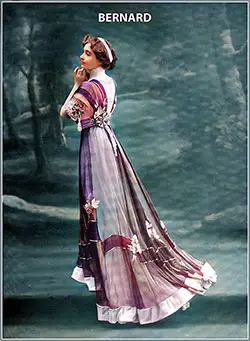
Alice Bernard: Parisian Designer for the Traveling Elite (1908–1926)
Blending precision tailoring with femininity, Bernard’s gowns were worn by transatlantic travelers, performers, and society patrons. Her designs offered refined silhouettes ideal for both Paris salons and glamorous shipboard dinners.
🍬 Did You Know?
Callot Soeurs were among the first couture houses to fight piracy in French courts — chasing down “style pirates” who copied their daring gowns. ✂️⚖️
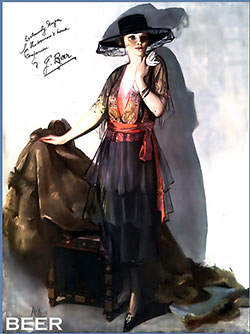
Gustav Beer: Parisian Elegance and Tailored Splendor
Beer’s mastery of structure and softness made him a favorite of the cosmopolitan traveler. His tailored yet feminine designs reflected refinement and ease, bridging Paris fashion and the culture of ocean liner society.

Henri Bendel: The Spirit of Paris in American Fashion (1916)
Bendel brought Parisian chic to America, blending wartime solidarity with haute couture flair. His work captured the spirit of elegance and adaptability, resonating with both U.S. society women and transatlantic voyagers.

Pierre Bulloz: Parisian Poetics in Silk and Satin
A painter turned couturier, Bulloz infused gowns with artistry and theatrical flair. His creations—loved by royals, opera stars, and travelers—captured motion, color, and luxury on both stage and sea.

Louise Chéruit: Timeless Parisian Couture, Yachting Style & Ocean Travel Elegance (1905–1930)
From tailored suits to daring evening gowns, Chéruit’s designs defined chic aboard transatlantic liners and Riviera yachts—blending femininity, function, and luxury .
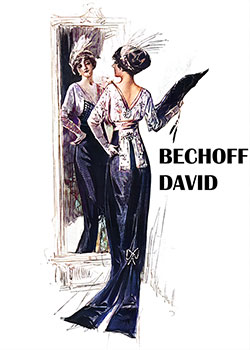
Siegfried David & Béchoff-David: Parisian Fashion Innovation and Ocean Travel Elegance (1900–1925)
Known for refined gowns and cultural motifs, Béchoff-David blended Parisian couture with East–West influences. Their designs suited ocean liner wardrobes and salon society alike.

Knitted Elegance & Travel-Ready Couture: The House of Dorat (1920–1922)
Specializing in silk and wool jersey, Dorat championed knitted gowns, tailored suits, and chic sportswear. Perfect for ocean voyages, her designs combined practicality with youthful Parisian charm.
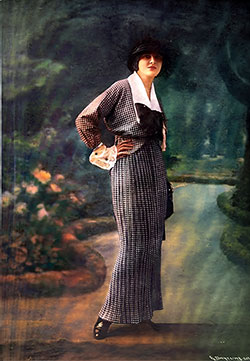
House of Doucet: Parisian Lace, Elegance & Ocean Travel Couture (1816–1920s)
Known for lace, flowing gowns, and refined sobriety, Jacques Doucet’s fashion house shaped Parisian style and catered to elite ocean travelers seeking elegance without eccentricity.
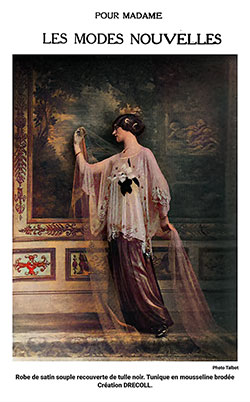
Christopher Drécoll: High Style for the Ocean-Going Elite (1908–1926)
From afternoon costumes to Mandarin coats, Drécoll offered dramatic, functional elegance for first-class passengers. His bold use of texture, color, and global motifs defined elite travel fashion.
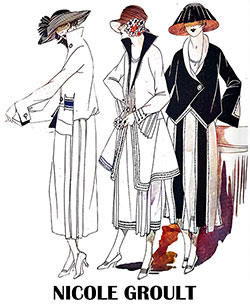
Nicole Groult: Parisian Fashion Innovator of the 1910s–1920s
Sister of Paul Poiret, Nicole Groult blended modern chic with historic influences. Her couture—tailored suits, embroidered gowns, and elegant capes—was worn by stylish women in Paris and aboard ocean liners. A perfect study in originality, refinement, and travel-ready fashion. ✨🧵🛳️
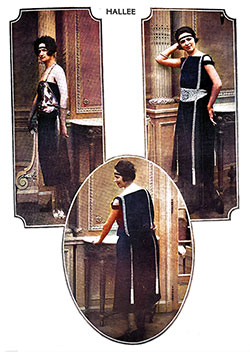
Jeanne Hallée: Parisian Couture for Ocean Travelers
Known for embroidered gowns, tailored suits, and inventive wraps, Jeanne Hallée’s fashions captured both Parisian chic and the needs of transatlantic voyagers in the 1910s–1920s. 🎩👗🛳️

Berthe Hermance: Fashion Legacy from Paris to the Promenade Deck (1919–1921)
Hermance’s gowns embodied refined post-WWI Parisian elegance. With embroidered satins and travel-ready designs, she dressed women for promenades ashore and aboard ocean liners.
💡 Did You Know?
Paul Poiret, called the “King of Fashion,” designed a special travel outfit for his wife’s trip home on the famous ocean liner RMS Lusitania in 1913! 🎩🚢

Jeanne Lanvin: Youth, Elegance & Transatlantic Style (1908–1920s)
Lanvin’s fashions embraced youthful elegance and became staples for ocean-going debutantes, actresses, and independent women traveling the Atlantic.
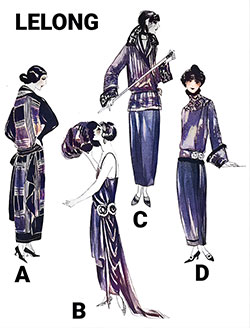
Lucien Lelong: Bridging Couture, Cinema & Ocean Elegance
Lelong’s designs reflected movement and modernity, shaping couture for film stars and ocean travelers alike during the 1920s.
💡 Did You Know?
Jean Patou helped define the look of the 1920s with sleek tailoring and stylish sportswear — including tennis outfits worn by star athletes like Helen Wills. 🎾👗

Madeleine et Madeleine: Couture Innovation for Travel
Known for inventive draping and refined style, Madeleine et Madeleine dressed Parisian women for shipboard evenings and society salons.
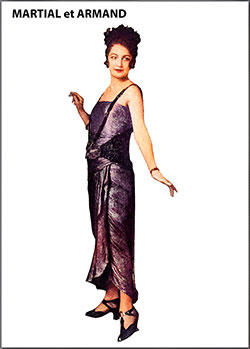
Martial et Armand: Tailored Elegance by the Sea
Specialists in sharp tailoring and seaside style, Martial et Armand balanced tradition and flair for fashionable travelers.
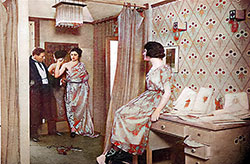
Melnotte-Simonin: Painterly Couture & Ocean Elegance
Melnotte-Simonin fused artistry and couture, designing for motion, color, and grace—perfect for the traveler’s wardrobe at sea.
💡 Did You Know?
Jeanne Paquin, known as the “Czarina of Fashion,” was one of the first women to run a major Paris fashion house — a bold step at the turn of the 20th century. 👑✂️
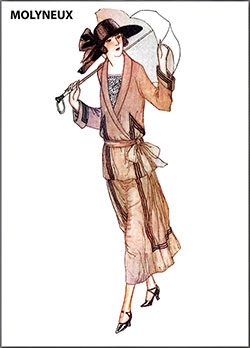
Edward Molyneux: Ocean Travel, Elegance & Empowerment
Molyneux’s chic simplicity defined the modern traveler’s wardrobe—sleek dresses and suits for promenades, ports, and shipboard salons.

Jeanne Paquin: Czarina of Dress & Ocean Travel Icon
Paquin combined feminism and haute couture, dressing women for both public independence and refined appearances aboard luxury liners.
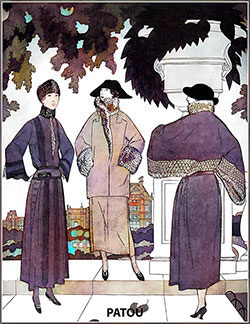
Jean Patou: Tailoring & Ocean Travel Elegance
Patou’s masterful tailoring brought sophistication to travel wardrobes, balancing comfort with couture for transatlantic passengers.
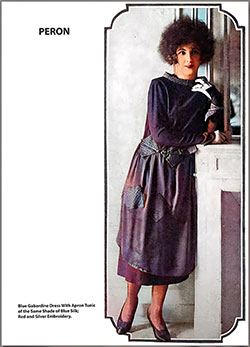
House of Peron: Elegance in Transit (1920)
Peron revived couture with elegant, travel-ready designs, embodying the sophistication of the steamship era’s society passengers.

Known as the “King of Fashion,” Paul Poiret transformed early 20th-century style with bold silhouettes, exotic influences, and innovative theater and travel wardrobes.
🍬 Did You Know?
Jenny SacerdoteKnown for her iconic “little grey suit” and exquisite couture, Jenny was as celebrated for her presence as her designs. Her 1921 portrait by Henri Gervex shows her as both a fashion innovator and a cultural icon of Paris and ocean travel society.

Premet: Parisian Fashion House of Travel Elegance and Modern Couture
Discover the legacy of Premet, a Parisian fashion house blending elegance and practicality. From Bengaline travel outfits to wartime serge gowns, explore how Premet shaped fashion for ocean travelers, students, genealogists, and historians alike.
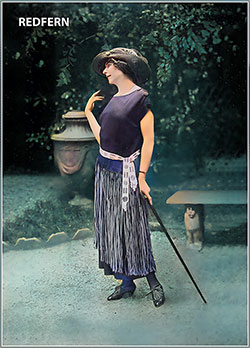
🎩 House of Redfern: Yachting Suits to Evening Gowns
Redfern evolved from tailored yachting wear to couture gowns, outfitting society women and ocean travelers in timeless elegance.
Jenny Sacerdote: Parisian Couture & the “Little Grey Suit”
Celebrated for chic tailoring and glamorous gowns, Jenny’s designs blended practical elegance with Parisian flair—perfect for the stylish traveler of the steamship era. 🎩👗🛳️
💡 Did You Know?
Jenny was immortalized in a 1921 portrait by painter Henri Gervex, which shows her as stylish and commanding as the gowns she created. Her image was as much a part of her brand as her couture.

John Tollmann: Parisian Fashion Designer of Stage and Ocean Elegance (1910s–1920s)
Explore John Tollmann’s dramatic couture blending stage design, Parisian elegance, and ocean travel fashion. Discover how his gowns reflected 1920s style for cosmopolitan women across continents.

Madeleine Vionnet: Queen of the Bias Cut and Ocean Travel Couture (1920s–1930s)
Explore Madeleine Vionnet, the Queen of the Bias Cut, whose designs shaped modern fashion and ocean travel elegance. Discover her salon, innovations, and legacy in couture history.
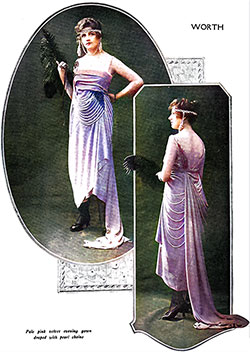
Pioneer of Haute Couture and Ocean Travel Elegance (1858–1920s)
Discover the House of Worth, the first great Parisian couture house. Learn how Charles Frederick Worth revolutionized fashion, influenced ocean travel wardrobes, and shaped global couture history.
🍬 Did You Know?
Jenny Sacerdote (Jeanne Adèle Bernard) became world-famous for her “little grey suit” — a tailored ensemble that redefined modern elegance. Practical yet refined, it was a favorite among ocean travelers who needed chic outfits that worked both on deck and ashore. 🧳🛳️👗

House of Zimmermann: Parisian Fashion Designer of Elegance and Ocean Travel Influence (1909–1930s)
Discover the House of Zimmermann, a Parisian couture house famed for elegant, practical gowns and its influence on ocean travel fashion. Explore designs, images, and fashion history for genealogists, students, and historians.
🎓 Educational Encouragement
💡 Students! Whether you're writing about fashion and identity, transatlantic travel, or the rise of modern femininity, the GG Archives offers rich primary sources and rare images you won’t find in textbooks. Use them to bring your essays, presentations, or projects to life.
🧾 Teachers: This index is ideal for cross-curricular instruction in fashion history, women’s studies, and early 20th-century world history. Ask your students:
- What does fashion say about class, culture, and movement?
- How did global travel shape identity and gender expectations?
Did you Know?
In all the important dressmaking firms, the salaried staff, first hands, saleswomen, clerks, etc., in short, all those who are in direct touch with the public, receive the midday meal and sometimes an evening meal as part of their salary. The workwomen are generally paid by the day and their meal is not included. (Harmony in Dress, 1926)
📚 How to Cite This Page
Chicago Style
Gjenvick-Gjønvik Archives. *Paris Fashion Houses and Ocean Travel Culture (1880–1930).* GG Archives. Last modified September 17, 2025. [https://www.ggarchives.com/OceanTravel/Fashions/FashionHouses/index.html](https://www.ggarchives.com/OceanTravel/Fashions/FashionHouses/index.html)
APA Style
Gjenvick-Gjønvik Archives. (1880–1930). *Paris Fashion Houses and Ocean Travel Culture (1880–1930).* GG Archives. Retrieved September 17, 2025, from [https://www.ggarchives.com/OceanTravel/Fashions/FashionHouses/index.html](https://www.ggarchives.com/OceanTravel/Fashions/FashionHouses/index.html)
MLA Style
Gjenvick-Gjønvik Archives. *Paris Fashion Houses and Ocean Travel Culture (1880–1930).* GG Archives, 1880–1930. Web. Accessed 17 Sept. 2025. [https://www.ggarchives.com/OceanTravel/Fashions/FashionHouses/index.html](https://www.ggarchives.com/OceanTravel/Fashions/FashionHouses/index.html)

